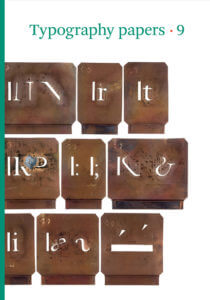Typography papers 9
In this ninth volume of Typography papers, we range widely over time and topic in pursuit of compelling narratives.
Some scholars have argued that letterforms called ‘Romanesque’ lack stable characteristics of their own, and are only transitional between Carolingian and Gothic letterforms. Gerard Unger counters this view by drawing together identifiable Romanesque characteristics traceable across much of Europe, and which were remarkably durable, if bewilderingly varied and interchangeable.
In the 1690s, an encyclopedic ‘description of trades’ was begun by the Académie royale des Sciences in Paris. The first trade examined was printing. Texts about it were written by two ‘technicians’, one of whom was Gilles Filleau des Billettes. Among the topics he addressed was stencilling. Eric Kindel presents a reconstruction of the equipment described, and reflects on its use. Four appendices, including two by Fred Smeijers, explore related matters in detail. The reconstruction is accompanied by Des Billettes’s text, which is published now for the first time. More information about Des Billettes and the Description des arts et métiers is provided by James Mosley.
Maurice Göldner assembles a history of the Dresden typefoundry Brüder Butter, partly from meagre archival resources that survived the Second World War, but also from a wealth of inventive type specimens issued by the foundry. Themes of international marketing and a fascination with decorative typographic ornaments and modular systems – from Jugendstil to outright Modernist – emerge from this rich resource, allowing us to reconsider Brüder Butter’s reputation among German typefoundries.
A dispute, often vehement, between two psychologists about readability, legibility, and their definition forms the narrative presented by William Berkson and Peter Enneson. By comparing the methodologies and publications of Matthew Luckiesh and Miles Tinker, they uncover the origins of the distinction (or confusion?) between readability and legibility, as understood by typographers and psychologists. Reappraising Luckiesh’s approach to readability, they believe, will expand our understanding of the complexity of reading.
Dictionaries are thought of as books of words, but Paul Luna concentrates on the illustrations that accompany dictionary definitions. While the most common form of illustration from the 1850s to the 1960s was the small black-and-white wood engraving or line drawing, he shows that innovative colour illustrations in recent dictionaries explain the relationships between words as well as define objects.
Simplification of the Arabic script for quicker and more efficient typesetting has brought advantages – and compromises – to Arabic language publishing. Titus Nemeth investigates the most successful project of simplification, a collaboration between a Lebanese newspaper owner-editor and the British Linotype company. He assesses the typeface that resulted, Mrowa-Linotype Simplified Arabic.
More than four years have passed since the previous volume of Typography papers, edited by our esteemed colleague, the late Paul Stiff. He began the venture in 1996 with the notice that ‘Whatever else it is claimed to be, typography is design for reading.’ We hope to continue with Paul’s generous idea of typography, and dedicate this volume to his memory.
EK & PL Reading, October 2013
Gerard Unger:
Romanesque capitals in inscriptions
This essay presents an overview of Romanesque capitals in inscriptions. They are first placed in the scene of the Romanesque period, then discussed in respect of their characteristics, both as individual letterforms and as part of inscriptions. Their origins are considered, as are relationships between manuscript and inscriptional uses. Explanations for the positioning and distribution of capitals in inscriptions are also proposed. An album provides additional examples of inscriptions from the period. The essay concludes with a brief review of revivals of Romanesque capitals that have appeared in subsequent centuries, up to the present day.
Eric Kindel:
A reconstruction of stencilling based on the description by Gilles Filleau des Billettes
with two appendices by Fred Smeijers
This essay recounts and illustrates a reconstruction and testing of tools, furniture, and working methods for stencilling texts. The description of stencilling on which the reconstruction is based was written by Gilles Filleau des Billettes as part of work on a ‘description of trades’ (Description des arts et métiers) begun in 1693 and carried out under the direction of the Académie royale des Sciences, Paris. From the reconstruction, observations and conclusions are drawn about the effectiveness of the tools, furniture, and working methods Des Billettes describes, and their likely relationship to stencilling practices of the time. Four appendices address Des Billettes’s instructions for designing and spacing letters, the cutting of stencils with chisels, the engraving by Louis Simonneau that accompanies the description, and later stencil materials that incorporate features similar to those described by Des Billettes.
Eric Kindel (ed.):
The description of stencilling by Gilles Filleau des Billettes: transcription and translation
This article presents the description of stencilling by Gilles Filleau des Billettes. The French text, approximately 10,000 words in length, is here transcribed and accompanied by a parallel English translation. Introductory notes on the preparation of both texts are provided; images of stencil letters found among the papers of Sébastien Truchet, Des Billettes’s colleague, are shown in an appendix.
James Mosley:
A note on Gilles Filleau des Billettes
This note provides biographical details of Gilles Filleau des Billettes (1634–1720), one of a group of ‘technicians’ recruited to work on the project for an encyclopedic ‘description of trades’ (Description des arts et métiers), carried out under the direction of the Académie royale des Sciences in Paris. A brief account of this work, and Des Billettes’s part in it, is also given, which includes references to his text on stencilling that is transcribed and translated elsewhere in this volume. Additional remarks describe the fate of the project in the later eighteenth century.
Maurice Göldner:
The Brüder Butter typefoundry
This essay seeks to construct a history of the Brüder Butter typefoundry from the few archival sources that remain following the destruction of Dresden in 1945, and from the rich collection of type specimens that the foundry issued from the turn of the twentieth century. The specimens – well designed and printed – illustrate not only the foundry’s range of typefaces, but also trace its business expansion through export, the incorporation of type designs from the USA and other sources into its repertoire, and the development of modular ornaments and type systems.
William Berkson & Peter Enneson:
Readability: discovery and disputation
This essay recovers the breakthrough work on readability done by Matthew Luckiesh in collaboration with the Mergenthaler Linotype company. In the late 1930s, Luckiesh developed the concept of readability as ease of reading continuous text; he also discovered that he could measure readability by studying blink rate during reading. After describing how Luckiesh began research in typography, his collaboration with Linotype is explained. The views of, and reaction to, this work by the typeface designer W. A. Dwiggins are also presented. The validity of Luckiesh’s work was attacked by psychologist Miles Tinker. Tinker’s own background and work are presented, along with the several dimensions of his dispute with Luckiesh. An argument is put forward that, in the light of methodological standards then and now, Tinker’s case against the work of Luckiesh is not sound. The essay concludes with reflections on the reception and value of both Tinker and Luckiesh today, and on the insights Luckiesh’s work in particular may bring to the practice of typography and research into reading.
Paul Luna:
Picture this: how illustrations define dictionaries
This essays surveys developments in the illustration of English dictionaries from the earliest printed editions to the present. Illustrations both support definitions and provide cultural context, especially in dictionaries for learners of English. A development is traced from the use of individual images depicting objects to the wider use of more complex illustrations that depict actions, processes, and systems. The way that these are integrated with the text of the dictionary is also considered. Competition between learners’ dictionaries in recent years has led to the increased use of full-page colour illustrations as marketable ‘features’.
Titus Nemeth:
Simplified Arabic: a new form of Arabic type for hot metal composition
This essay is an investigation into the origins of Simplified Arabic, a typeface developed in the 1950s by the British Linotype company in collaboration with Kamel Mrowa, owner and editor-in-chief of the Lebanese newspaper al-Hayat. The essay situates the development of Simplified Arabic within a broader geopolitical context of the Middle East after the Second World War, explains the design concepts underpinning the typeface in relation to the technical requirements of 1950s newspaper production, and assesses the design of the typeface itself. Additional discussion addresses the simplified Arabic typeface introduced subsequently by Intertype, Linotype’s competitor, and compares the simplified typefaces of both companies. Brief consideration is given to Simplified Arabic’s influence and its lasting impact on Arabic typeface design.
Typography papers [9] is edited, designed, and prepared for press in the Department of Typography & Graphic Communication, University of Reading (www.reading.ac.uk/ typography) and published by Hyphen Press, London (www.hyphenpress.co.uk).
Editors: Eric Kindel & Paul Luna
Editorial support for this volume: Mary Dyson, Robin Kinross, Ole Lund, Alice Savoie
Designer: Eric Kindel
Typeset and made-up using Adobe InDesign CS6 with typefaces from the OurType Arnhem Pro, Arnhem Fine, and Fresco Sans families by Fred Smeijers, Antwerp; and from the Adobe Arabic family. Thanks to OurType for supplying additional transliteration glyphs used in Nemeth.
Production at Reading: image editing by Michael Johnston, Design & Print Studio, University of Reading.
Printed in Belgium by Die Keure, Bruges, on Lessebo Design Smooth Natural, 115 gsm. Bound by Sepeli NV, Evergem.
ISBN 978-0-907259-48-0
Copyright © 2013 Typography papers, the authors, and the Department of Typography & Graphic Communication.
All rights reserved. No part of this publication may be reproduced, stored in a retrieval system, or transmitted in any form or by any means, without the written permission of the copyright holder.
Front cover: stencils cut by Fred Smeijers, based on Des Billettes (see pp. 28 ff).
Back cover: Letters marked out from stencils, based on Des Billettes (see pp. 28 ff); (paired images at left, from top left) self-portrait of Gerlachus, c. 1150 (see pp. 5 ff); stenciller, from an engraving by Louis Simonneau, 1701 (see pp. 28 ff); detail of a specimen cover, Brüder Butter typefoundry, c. 1913 (see pp. 91 ff); Matthew Luckiesh lecturing, c. 1940s (see pp. 117 ff); illustrated entry from the Longman Dictionary of Contemporary English (1995) (see pp. 153 ff); specimen for Linotype Yakout, formerly Mrowa-Linotype Simplified Arabic (see pp. 173 ff).

Gerard Unger:
Romanesque capitals in inscriptions [PDF]
Eric Kindel:
A reconstruction of stencilling based on the description by Gilles Filleau des Billettes [PDF]
with two appendices by Fred Smeijers
Eric Kindel (ed.):
The description of stencilling by Gilles Filleau des Billettes: transcription and translation [PDF]
James Mosley:
A note on Gilles Filleau des Billettes [PDF]
Maurice Göldner:
The Brüder Butter typefoundry [PDF]
William Berkson & Peter Enneson:
Readability: discovery and disputation [PDF]
Paul Luna:
Picture this: how illustrations define dictionaries [PDF]
Titus Nemeth:
Simplified Arabic: a new form of Arabic type for hot metal composition [PDF]
